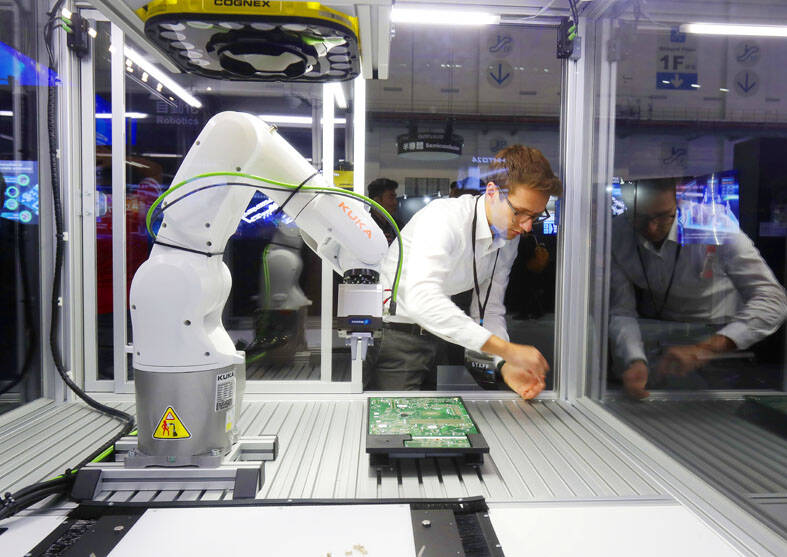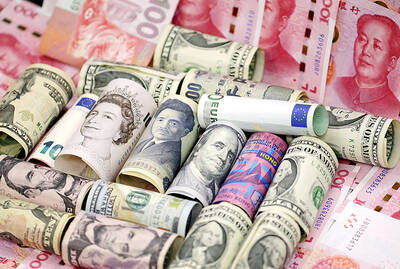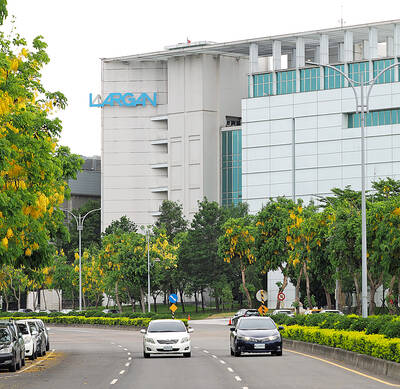The industrial production index expanded 8.85 percent annually to 100.6 last month as robust demand for artificial intelligence (AI) applications and high-performance computing (HPC) devices fueled demand for advanced chips and data centers, the Ministry of Economic Affairs said yesterday.
The index measures the change in the value of output produced by the local manufacturing, mining and utilities sectors, with the manufacturing output, the major pillar of industrial production, growing 9.32 percent year-on-year to 100.51 last month.
Industrial and manufacturing production registered an eighth consecutive month of annual growth last month.

Photo: Chiang Ying-ying, AP
During the first 10 months of this year, industrial production and manufacturing production grew 10.68 percent and 11.11 percent from the same period last year respectively.
“It looks like manufacturing production is on track to grow for the whole of this year, ending two consecutive years of decline,” Department of Statistics Deputy Director-General Huang Wei-jie (黃偉傑) said by telephone yesterday. “The outlook for the first quarter of next year remains unclear. A major uncertainty is the US trade policies under [US president-elect] Donald Trump. We are closely monitoring how it will play out.”
This month, manufacturing production is expected to climb between 5.8 percent and 10.1 percent annually to between 98.08 and 102.08, the ministry forecast.
On a sequential basis, manufacturing production would shrink 2.4 percent in the worst-case scenario due to a disappointing recovery of the traditional sectors, which were affected by China’s economic slowdown and industrial overcapacity, Huang said.
Among the six major industries in the manufacturing sector, three posted an annual output expansion last month, with the electronic components industry reporting the largest increase of 16.47 percent, benefiting from rising demand for HPC and AI devices, which boosted demand for 12-inch wafers, chip design and chip testing and packaging services, the ministry said.
The production of computers and optical products last month rose 4.35 percent annually, thanks to sustained demand for AI applications and semiconductor inspection equipment, the ministry said.
Machinery equipment production expanded 11.06 percent last month, buoyed by robust equipment demand from semiconductor companies.
Demand for machine tools remained sluggish as slower global economic growth depressed firms’ investment in manufacturing equipment, it said.
The production of base metals contracted 3.52 percent last month due to sluggish steel demand worldwide and low-priced steel products from China, the ministry said.
The production of chemical materials and fertilizers dipped 5.01 percent last month as manufacturers cut production to cope with sagging demand. The decline was also a result of disruptions by typhoons last month, it added.
The production of automotive products plummeted 12.59 percent last month, attributable to component shortages and competition from global automakers, the ministry said.

Taiwan’s foreign exchange reserves hit a record high at the end of last month, surpassing the US$600 billion mark for the first time, the central bank said yesterday. Last month, the country’s foreign exchange reserves rose US$5.51 billion from a month earlier to reach US$602.94 billion due to an increase in returns from the central bank’s portfolio management, the movement of other foreign currencies in the portfolio against the US dollar and the bank’s efforts to smooth the volatility of the New Taiwan dollar. Department of Foreign Exchange Director-General Eugene Tsai (蔡炯民)said a rate cut cycle launched by the US Federal Reserve

Handset camera lens maker Largan Precision Co (大立光) on Sunday reported a 6.71 percent year-on-year decline in revenue for the third quarter, despite revenue last month hitting the highest level in 11 months. Third-quarter revenue was NT$17.68 billion (US$581.2 million), compared with NT$18.95 billion a year earlier, the company said in a statement. The figure was in line with Yuanta Securities Investment Consulting Co’s (元大投顧) forecast of NT$17.9 billion, but missed the market consensus estimate of NT$18.97 billion. The third-quarter revenue was a 51.44 percent increase from NT$11.67 billion in the second quarter, as the quarter is usually the peak

Nvidia Corp’s major server production partner Hon Hai Precision Industry Co (鴻海精密) reported 10.99 percent year-on-year growth in quarterly sales, signaling healthy demand for artificial intelligence (AI) infrastructure. Revenue totaled NT$2.06 trillion (US$67.72 billion) in the last quarter, in line with analysts’ projections, a company statement said. On a quarterly basis, revenue was up 14.47 percent. Hon Hai’s businesses cover four primary product segments: cloud and networking, smart consumer electronics, computing, and components and other products. Last quarter, “cloud and networking products delivered strong growth, components and other products demonstrated significant growth, while smart consumer electronics and computing products slightly declined,” compared with the

The US government on Wednesday sanctioned more than two dozen companies in China, Turkey and the United Arab Emirates, including offshoots of a US chip firm, accusing the businesses of providing illicit support to Iran’s military or proxies. The US Department of Commerce included two subsidiaries of US-based chip distributor Arrow Electronics Inc (艾睿電子) on its so-called entity list published on the federal register for facilitating purchases by Iran’s proxies of US tech. Arrow spokesman John Hourigan said that the subsidiaries have been operating in full compliance with US export control regulations and his company is discussing with the US Bureau of